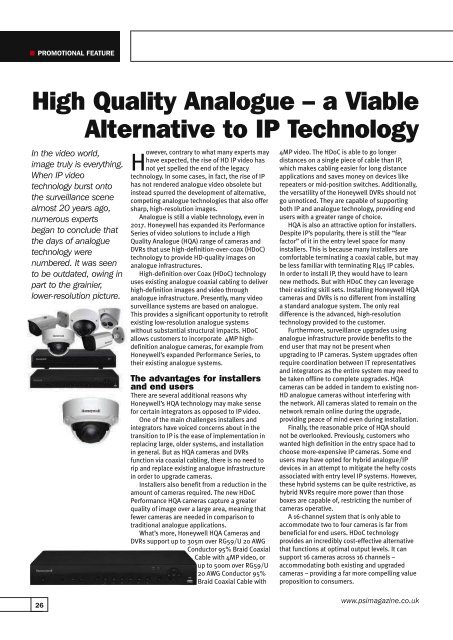PSISeptember2017a
Create successful ePaper yourself
Turn your PDF publications into a flip-book with our unique Google optimized e-Paper software.
PROMOTIONAL FEATURE<br />
High Quality Analogue – a Viable<br />
Alternative to IP Technology<br />
In the video world,<br />
image truly is everything.<br />
When IP video<br />
technology burst onto<br />
the surveillance scene<br />
almost 20 years ago,<br />
numerous experts<br />
began to conclude that<br />
the days of analogue<br />
technology were<br />
numbered. It was seen<br />
to be outdated, owing in<br />
part to the grainier,<br />
lower-resolution picture.<br />
However, contrary to what many experts may<br />
have expected, the rise of HD IP video has<br />
not yet spelled the end of the legacy<br />
technology. In some cases, in fact, the rise of IP<br />
has not rendered analogue video obsolete but<br />
instead spurred the development of alternative,<br />
competing analogue technologies that also offer<br />
sharp, high-resolution images.<br />
Analogue is still a viable technology, even in<br />
2017. Honeywell has expanded its Performance<br />
Series of video solutions to include a High<br />
Quality Analogue (HQA) range of cameras and<br />
DVRs that use high-definition-over-coax (HDoC)<br />
technology to provide HD-quality images on<br />
analogue infrastructures.<br />
High-definition over Coax (HDoC) technology<br />
uses existing analogue coaxial cabling to deliver<br />
high-definition images and video through<br />
analogue infrastructure. Presently, many video<br />
surveillance systems are based on analogue.<br />
This provides a significant opportunity to retrofit<br />
existing low-resolution analogue systems<br />
without substantial structural impacts. HDoC<br />
allows customers to incorporate 4MP highdefinition<br />
analogue cameras, for example from<br />
Honeywell’s expanded Performance Series, to<br />
their existing analogue systems.<br />
The advantages for installers<br />
and end users<br />
There are several additional reasons why<br />
Honeywell’s HQA technology may make sense<br />
for certain integrators as opposed to IP video.<br />
One of the main challenges installers and<br />
integrators have voiced concerns about in the<br />
transition to IP is the ease of implementation in<br />
replacing large, older systems, and installation<br />
in general. But as HQA cameras and DVRs<br />
function via coaxial cabling, there is no need to<br />
rip and replace existing analogue infrastructure<br />
in order to upgrade cameras.<br />
Installers also benefit from a reduction in the<br />
amount of cameras required. The new HDoC<br />
Performance HQA cameras capture a greater<br />
quality of image over a large area, meaning that<br />
fewer cameras are needed in comparison to<br />
traditional analogue applications.<br />
What’s more, Honeywell HQA Cameras and<br />
DVRs support up to 305m over RG59/U 20 AWG<br />
Conductor 95% Braid Coaxial<br />
Cable with 4MP video, or<br />
up to 500m over RG59/U<br />
20 AWG Conductor 95%<br />
Braid Coaxial Cable with<br />
4MP video. The HDoC is able to go longer<br />
distances on a single piece of cable than IP,<br />
which makes cabling easier for long distance<br />
applications and saves money on devices like<br />
repeaters or mid-position switches. Additionally,<br />
the versatility of the Honeywell DVRs should not<br />
go unnoticed. They are capable of supporting<br />
both IP and analogue technology, providing end<br />
users with a greater range of choice.<br />
HQA is also an attractive option for installers.<br />
Despite IP’s popularity, there is still the “fear<br />
factor” of it in the entry level space for many<br />
installers. This is because many installers are<br />
comfortable terminating a coaxial cable, but may<br />
be less familiar with terminating RJ45 IP cables.<br />
In order to install IP, they would have to learn<br />
new methods. But with HDoC they can leverage<br />
their existing skill sets. Installing Honeywell HQA<br />
cameras and DVRs is no different from installing<br />
a standard analogue system. The only real<br />
difference is the advanced, high-resolution<br />
technology provided to the customer.<br />
Furthermore, surveillance upgrades using<br />
analogue infrastructure provide benefits to the<br />
end user that may not be present when<br />
upgrading to IP cameras. System upgrades often<br />
require coordination between IT representatives<br />
and integrators as the entire system may need to<br />
be taken offline to complete upgrades. HQA<br />
cameras can be added in tandem to existing non-<br />
HD analogue cameras without interfering with<br />
the network. All cameras slated to remain on the<br />
network remain online during the upgrade,<br />
providing peace of mind even during installation.<br />
Finally, the reasonable price of HQA should<br />
not be overlooked. Previously, customers who<br />
wanted high definition in the entry space had to<br />
choose more-expensive IP cameras. Some end<br />
users may have opted for hybrid analogue/IP<br />
devices in an attempt to mitigate the hefty costs<br />
associated with entry level IP systems. However,<br />
these hybrid systems can be quite restrictive, as<br />
hybrid NVRs require more power than those<br />
boxes are capable of, restricting the number of<br />
cameras operative.<br />
A 16-channel system that is only able to<br />
accommodate two to four cameras is far from<br />
beneficial for end users. HDoC technology<br />
provides an incredibly cost-effective alternative<br />
that functions at optimal output levels. It can<br />
support 16 cameras across 16 channels –<br />
accommodating both existing and upgraded<br />
cameras – providing a far more compelling value<br />
proposition to consumers.<br />
26<br />
www.psimagazine.co.uk

















